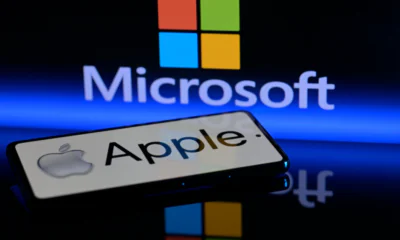Artificial Intelligence
From Siri to ReALM: Apple’s Journey to Smarter Voice Assistants

Since Siri's launch in 2011, Apple has consistently been at the forefront of voice assistant innovation, adapting to global user needs. The introduction of ReALM marks a significant point in this journey, offering a glimpse into the evolving role of voice assistants in our interaction with the devices. This article examines the effects of ReALM on Siri and the potential directions for future voice assistants.
The Rise of Voice Assistants: Siri’s Genesis
The journey began when Apple integrated Siri, a sophisticated artificial intelligence system, into its devices, transforming how we interact with our technology. Originating from technology developed by SRI International, Siri became the gold standard for voice-activated assistants. Users could perform tasks like internet searches and scheduling through simple voice commands, pushing the boundaries of conversational interfaces and igniting a competitive race in the voice assistant market.
Siri 2.0: A New Era of Voice Assistants
As Apple gears up for the release of iOS 18 at the Worldwide Developers Conference (WWDC) in June 2024, anticipation is building within the tech community for what is expected to be a significant evolution of Siri. This new phase, referred to as Siri 2.0, promises to bring generative AI advancements to the forefront, potentially transforming Siri into an even more sophisticated virtual assistant. While the exact enhancements remain confidential, the tech world is abuzz with the prospect of Siri achieving new heights in conversational intelligence and personalized user interaction, leveraging the kind of sophisticated language learning models seen in technologies like ChatGPT. In this context, the introduction of ReALM, a compact language model, suggests possible enhancements that Siri 2.0 might introduce for its users. The following sections will discuss the role of ReALM and its potential influence as an important step in the ongoing advancement of Siri.
Unveiling ReALM
ReALM, which stands for Reference Resolution As Language Modeling, is a specialized language model adept at deciphering contextual and ambiguous references during conversations, such as “that one” or “this.” It stands out for its ability to process conversational and visual references, transforming them into a text format. This capability enables ReALM to interpret and interact with screen layouts and elements seamlessly within a dialogue, a critical feature for accurately handling queries in visually dependent contexts.
The architecture of ReALM ranges from smaller versions like ReALM-80M to larger ones such as ReALM-3B, are optimized to be computationally efficient for integration into mobile devices. This efficiency allows for consistent performance with reduced power use and less strain on processing resources, important for extending battery life and providing swift response times on a variety of devices.
Furthermore, ReALM's design accommodates modular updates, facilitating the seamless integration of the latest advancements in reference resolution. This modular approach not only enhances the model's adaptability and flexibility but also ensures its long-term viability and effectiveness, allowing it to meet evolving user needs and technology standards across a broad spectrum of devices.
ReALM vs. Language Models
While traditional language models like GPT-3.5 mainly process text, ReALM takes a multimodal route, similar to models such as Gemini, by working with both text and visuals. Unlike the broader functionalities of GPT-3.5 and Gemini, which handle tasks like text generation, comprehension, and image creation, ReALM is particularly aimed at deciphering conversational and visual contexts. However, unlike multimodal models like Gemini which directly processes visual and text data, ReALM translates visual content of screens into text, annotating entities, and their spatial details. This conversion allows ReALM to interpret the screen content in a textual manner, facilitating more precise identification and understanding of on-screen references.
How ReALM Could Transform Siri?
ReALM could significantly enhance Siri's capabilities, transforming it into a more intuitive and context-aware assistant. Here's how it might impact:
- Better Contextual Understanding: ReALM specializes in deciphering ambiguous references in conversations, potentially greatly improving Siri's ability to understand context-dependent queries. This would allow users to interact with Siri more naturally, as it could grasp references like “play that song again” or “call her” without additional details.
- Enhanced Screen Interaction: With its proficiency in interpreting screen layouts and elements within dialogues, ReALM could enable Siri to integrate more fluidly with a device's visual content. Siri could then execute commands related to on-screen items, such as “open the app next to Mail” or “scroll down on this page,” expanding its utility in various tasks.
- Personalization: By learning from previous interactions, ReALM could improve Siri’s ability to offer personalized and adaptive responses. Over time, Siri might predict user needs and preferences, suggesting or initiating actions based on past behavior and contextual understanding, akin to a knowledgeable personal assistant.
- Improved Accessibility: The contextual and reference understanding capabilities of ReALM could significantly benefit accessibility, making technology more inclusive. Siri, powered by ReALM, could interpret vague or partial commands accurately, facilitating easier and more natural device use for people with physical or visual impairments.
ReALM and Apple’s AI Strategy
ReALM's launch reflects a key aspect of Apple's AI strategy, emphasizing on-device intelligence. This development aligns with the broader industry trend of edge computing, where data is processed locally on devices, reducing latency, conserving bandwidth, and securing user data on the device itself.
The ReALM project also showcases Apple's wider AI goals, focusing not only on command execution but also on a deeper understanding and prediction of user needs. ReALM represents a step towards future innovations where devices could provide more personalized and predictive support, informed by an in-depth grasp of user habits and preferences.
The Bottom Line
Apple's development from Siri to ReALM highlights a continued evolution in voice assistant technology, focusing on improved context understanding and user interaction. ReALM signifies a shift towards more intelligent, personalized, and privacy-conscious voice assistance, aligning with the industry trend of edge computing for enhanced on-device processing and security.












